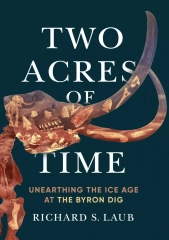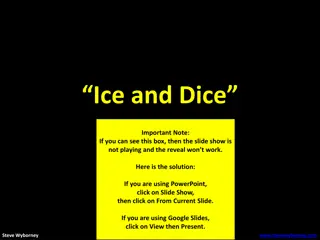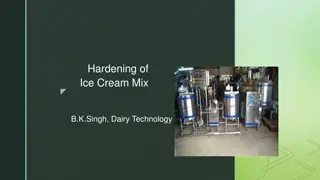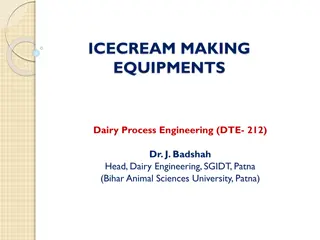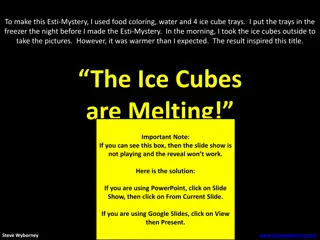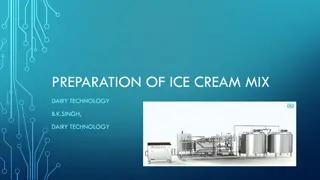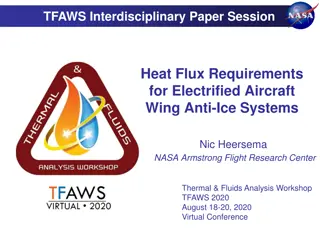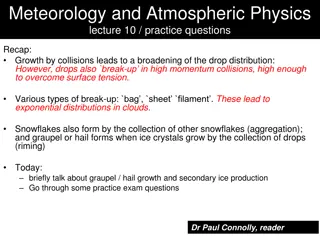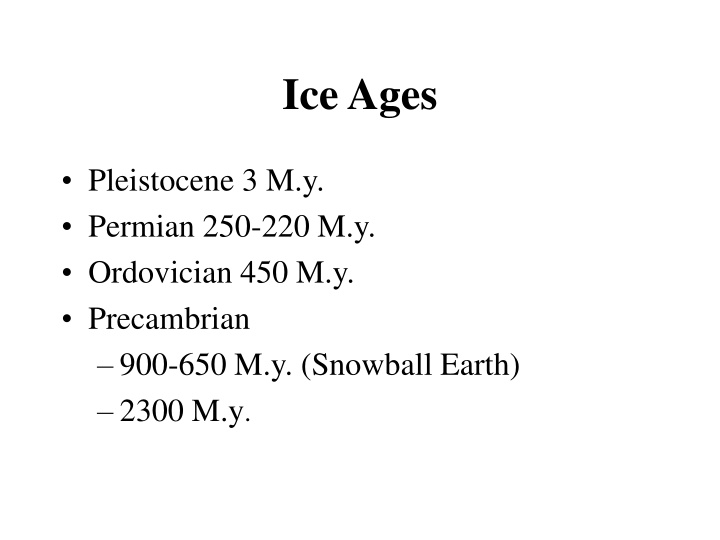
Earth's Ice Ages, Milankovitch Cycles, and the Greenhouse Effect
Explore the Earth's history of ice ages, Milankovitch cycles, and the greenhouse effect affecting climate change over thousands of years. Discover how factors like axis tilt, orbit shape, and precession impact global temperatures. Also, learn about the essential role of the greenhouse effect in maintaining Earth's habitable conditions.
Download Presentation

Please find below an Image/Link to download the presentation.
The content on the website is provided AS IS for your information and personal use only. It may not be sold, licensed, or shared on other websites without obtaining consent from the author. If you encounter any issues during the download, it is possible that the publisher has removed the file from their server.
You are allowed to download the files provided on this website for personal or commercial use, subject to the condition that they are used lawfully. All files are the property of their respective owners.
The content on the website is provided AS IS for your information and personal use only. It may not be sold, licensed, or shared on other websites without obtaining consent from the author.
E N D
Presentation Transcript
Ice Ages Pleistocene 3 M.y. Permian 250-220 M.y. Ordovician 450 M.y. Precambrian 900-650 M.y. (Snowball Earth) 2300 M.y.
Time (1000 Years) North America Alps Northern Europe Poland-Russia 0-18 18-67 67-128 128-180 180-230 230-300 300-330 330-470 470-540 540-550 550-585 585-600 600-2000 2000 (2 M.Y.) 4000 (4 M.Y.) 15 M.Y. Interglacial Vistula Eem Warthe/Saale Holstein Elster Cromer Wisconsin Sangamon Illinoisan Yarmouth Kansan Aftonian "Nebraskan " Wurm Uznach Riss Hoetting Mindel Varsovian Masovian Cracovian Sandomirian Jaroslavian Likhvin Menapian Gunz Waalian Weybourne Tiglian Donau II Donau I About 20 Glacial Advances Beginning of Pleistocene Dwarf forests still in Antarctica First Glaciation in Antarctica
Beginning of the Ice Ages
Milankovich Cycles Cool Summers More Important Than Cold Winters Tilt of Axis Shape of Orbit Precession Can t be the whole story-have operated throughout earth history
Axis Tilt Small Axis Tilt: Mild winters but cool summers. Favors Ice Age Large Axis Tilt: Cold winters but hot summers. Favors Interglacial
Axis Tilt and the Incredible Shrinking Tropics Earth s Axis Tilt is Shrinking 24.2 degrees 9,500 years ago 23.4 degrees now 22.6 degrees 10,200 years from now Tropics are shrinking 14.7 m/year = 4 cm/day = 1.7 mm/hour Temperate zones gain 1550 sq km/year 1080 at the expense of tropics 470 at the expense of Arctic and Antarctic
Precession: 26,000 year cycle
Shape of Orbit + Precession Summer at Perihelion (Eccentric Orbit) Cold winters but hot summers. Favors Interglacial Summer at Aphelion (Eccentric Orbit) Near-circular Orbit Mild winters but cool summers. Favors Ice Age
The Greenhouse Effect Without a natural Greenhouse Effect, earth would be frozen 90% due to Water Vapor Other contributors: carbon dioxide, methane, nitrous oxides A little Greenhouse Effect is a good thing Carl Sagan Problem: we are accelerating it with unknown final consequences
The Carbonate-Silicate Cycle Earth has almost as much carbon dioxide as Venus Volcanoes add carbon dioxide to the atmosphere Carbon dioxide is removed from the air to make carbonate rocks Icehouse and Greenhouse episodes
The Carbonate-Silicate Cycle Mountain-building favors cooling Uplift exposes rocks to weathering Calcium silicates (plagioclase, amphiboles, pyroxenes) are chemically weathered Calcium is carried to the sea where organisms bind it into carbonate minerals Creation of carbonates removes carbon dioxide from the atmosphere Weathering of carbonates returns carbon dioxide to the atmosphere
The Carbonate-Silicate Cycle Plate tectonics carries some carbonates into the earth Heat liberates carbon dioxide Carbon dioxide returns to the atmosphere The cycle does not require life but does require liquid water.
The Snowball Earth Between 900 and 600 m.y. ago, Earth froze completely (or almost) about four times Global freezing alternated with extremely rapid sea-level rise and global warming Evidence: Glacial deposits on all continents, even at low latitudes Glacial deposits immediately succeeded by thick deposits of carbonate rocks
The Snowball Earth Possible reasons: Fainter early sun Biological changes Global ice cover Weathering and erosion shut down Volcanoes continue to erupt CO2 At 10% CO2, abrupt warming begins Go from 50 C to +50 C in 10,000 years? Implications for life?
What Causes Ice Ages? Within Earth (Endogenic) Carbonate-Silicate Cycle Volcanic Eruptions - Sudden output of CO2 (warming) or particulates (cooling) Mountain Building - Changes in atmospheric circulation Continent-Ocean configuration Outside Earth (Exogenic) Changes in Sun (faint early sun) Variations in Earth Orbit (Milankovitch Cycles) Don't Really Know
Are We Headed For Another Ice Age? Heating & Cooling in Historic Times Smoke, Haze, CO2May Alter Climate Don't Really Know Global warming due to fossil fuels may be catastrophic in many ways, but will probably not much affect these longer-term cycles. We will have run out of fossil fuels long before the duration of a typical interglacial.
This powerpoint was kindly donated to www.worldofteaching.com http://www.worldofteaching.com is home to over a thousand powerpoints submitted by teachers. This is a completely free site and requires no registration. Please visit and I hope it will help in your teaching.

